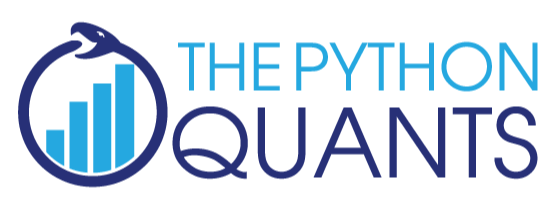|
# |
|
# Analyzing Returns from Geometric Brownian Motion |
|
# 03_stf/GBM_returns.py |
|
# |
|
# (c) Dr. Yves J. Hilpisch |
|
# Derivatives Analytics with Python |
|
# |
|
import math |
|
import numpy as np |
|
import pandas as pd |
|
import scipy.stats as scs |
|
import statsmodels.api as sm |
|
import matplotlib as mpl |
|
import matplotlib.pyplot as plt |
|
plt.style.use('seaborn') |
|
mpl.rcParams['font.family'] = 'serif' |
|
|
|
# |
|
# Helper Function |
|
# |
|
|
|
|
|
def dN(x, mu, sigma): |
|
''' Probability density function of a normal random variable x. |
|
|
|
Parameters |
|
========== |
|
mu : float |
|
expected value |
|
sigma : float |
|
standard deviation |
|
|
|
Returns |
|
======= |
|
pdf : float |
|
value of probability density function |
|
''' |
|
z = (x - mu) / sigma |
|
pdf = np.exp(-0.5 * z ** 2) / math.sqrt(2 * math.pi * sigma ** 2) |
|
return pdf |
|
|
|
# Return Sample Statistics and Normality Tests |
|
|
|
def print_statistics(data): |
|
print("RETURN SAMPLE STATISTICS") |
|
print("---------------------------------------------") |
|
print("Mean of Daily Log Returns %9.6f" % np.mean(data['returns'])) |
|
print("Std of Daily Log Returns %9.6f" % np.std(data['returns'])) |
|
print("Mean of Annua. Log Returns %9.6f" % (np.mean(data['returns']) * 252)) |
|
print("Std of Annua. Log Returns %9.6f" % \ |
|
(np.std(data['returns']) * math.sqrt(252))) |
|
print("---------------------------------------------") |
|
print("Skew of Sample Log Returns %9.6f" % scs.skew(data['returns'])) |
|
print("Skew Normal Test p-value %9.6f" % scs.skewtest(data['returns'])[1]) |
|
print("---------------------------------------------") |
|
print("Kurt of Sample Log Returns %9.6f" % scs.kurtosis(data['returns'])) |
|
print("Kurt Normal Test p-value %9.6f" % \ |
|
scs.kurtosistest(data['returns'])[1]) |
|
print("---------------------------------------------") |
|
print("Normal Test p-value %9.6f" % \ |
|
scs.normaltest(data['returns'])[1]) |
|
print("---------------------------------------------") |
|
print("Realized Volatility %9.6f" % data['rea_vol'].iloc[-1]) |
|
print("Realized Variance %9.6f" % data['rea_var'].iloc[-1]) |
|
|
|
# |
|
# Graphical Output |
|
# |
|
|
|
# daily quotes and log returns |
|
def quotes_returns(data): |
|
''' Plots quotes and returns. ''' |
|
plt.figure(figsize=(10, 6)) |
|
plt.subplot(211) |
|
data['index'].plot() |
|
plt.ylabel('daily quotes') |
|
plt.grid(True) |
|
plt.axis('tight') |
|
|
|
plt.subplot(212) |
|
data['returns'].plot() |
|
plt.ylabel('daily log returns') |
|
plt.grid(True) |
|
plt.axis('tight') |
|
|
|
# histogram of annualized daily log returns |
|
def return_histogram(data): |
|
''' Plots a histogram of the returns. ''' |
|
plt.figure(figsize=(10, 6)) |
|
x = np.linspace(min(data['returns']), max(data['returns']), 100) |
|
plt.hist(np.array(data['returns']), bins=50, normed=True) |
|
y = dN(x, np.mean(data['returns']), np.std(data['returns'])) |
|
plt.plot(x, y, linewidth=2) |
|
plt.xlabel('log returns') |
|
plt.ylabel('frequency/probability') |
|
plt.grid(True) |
|
|
|
# Q-Q plot of annualized daily log returns |
|
def return_qqplot(data): |
|
''' Generates a Q-Q plot of the returns.''' |
|
plt.figure(figsize=(10, 6)) |
|
sm.qqplot(data['returns'], line='s') |
|
plt.grid(True) |
|
plt.xlabel('theoretical quantiles') |
|
plt.ylabel('sample quantiles') |
|
|
|
# realized volatility |
|
def realized_volatility(data): |
|
''' Plots the realized volatility. ''' |
|
plt.figure(figsize=(10, 6)) |
|
data['rea_vol'].plot() |
|
plt.ylabel('realized volatility') |
|
plt.grid(True) |
|
|
|
# mean return, volatility and correlation (252 days moving = 1 year) |
|
def rolling_statistics(data): |
|
''' Calculates and plots rolling statistics (mean, std, correlation). ''' |
|
plt.figure(figsize=(11, 8)) |
|
|
|
plt.subplot(311) |
|
mr = pd.rolling_mean(data['returns'], 252) * 252 |
|
mr.plot() |
|
plt.grid(True) |
|
plt.ylabel('returns (252d)') |
|
plt.axhline(mr.mean(), color='r', ls='dashed', lw=1.5) |
|
|
|
plt.subplot(312) |
|
vo = pd.rolling_std(data['returns'], 252) * math.sqrt(252) |
|
vo.plot() |
|
plt.grid(True) |
|
plt.ylabel('volatility (252d)') |
|
plt.axhline(vo.mean(), color='r', ls='dashed', lw=1.5) |
|
vx = plt.axis() |
|
|
|
plt.subplot(313) |
|
co = pd.rolling_corr(mr, vo, 252) |
|
co.plot() |
|
plt.grid(True) |
|
plt.ylabel('correlation (252d)') |
|
cx = plt.axis() |
|
plt.axis([vx[0], vx[1], cx[2], cx[3]]) |
|
plt.axhline(co.mean(), color='r', ls='dashed', lw=1.5) |

